The Fantasy Genre has long been dominated by the religions and customs of countries touched on by the Crusades. While this makes sense, with the familiar image of a knight wandering foreign lands being key to the genre itself, there has been stagnation in recent times. As such, I’ve taken it upon myself to look into the cultures of the world and find fascinating details about other mythologies often overlooked by the genre we so love, going on a bit of a tour of world mythologies.
The cultures of Europe and Africa have had some interactions with each other in the past, especially along the Mediterranean coasts. Egyptian mythology influenced Greek, as did Amazigh, and the same could be said the other way around. Many have known of the influences of Christianity on modern day Voudou and related groups. But that blend is rarely so complete that it would be difficult to know the origins of which belief came from what group. Though sometimes the details get lost to history, like with Poseidon being part of the mythology of the Amazigh long before being introduced to the Greeks, there is still some evidence from long ago that makes it possible to separate the two.
But what happens when that blend is a lot more complete and a mythology starts to form after the blending?
Behold, the beauty of the mythology that is Brazil. Having been settled by the Portuguese during the colonial period, Brazil’s culture was heavily influenced from not one direction but rather three fully unique sources. The first, of course, was the indigenous people of the region, the Tupians in particular – a group defined by their language group, Tupian, which includes 70 different dialects. Then, as the Portuguese arrived, they did what Europeans generally do and tried to convert the country, introducing a whole new language and their culture. And, as the Portuguese arrived, they also brought along slaves, as the Europeans tended to do at the time, and introduced the unique flavors of the Western African cultures covered in earlier entries of this series.
The result was a wonderfully complex blend of the cultures of three different continents playing off of each other and creating something new. While the origins of some ideas are easy to identify, most are a gestalt which has grown greater than the sum of its parts. A creature shaped like something from the Amazon could behave like an African deity, be associated with a Christian concept, and have a name based on the Portuguese translation of a Tupian word.
So, while it would be impossible to cover the whole of such a rich culture in the space of a lowly blog like mine, it’s a time to give a brief look into the world of…
Brazilian Mythology

Claimed by the Portuguese in the 1500s, Brazil has had a long time to let the different flavors of their country come together. Originally the land of an already diverse indigenous group, the inclusion of Catholicism to the region and the folklore of the Iberian Peninsula introduced concepts such as saints and some animals which the locals had never seen before. Combined with the traditions of the African people brought into the country by the Portuguese, this made for a situation where the things which united them gradually became stronger while the things which divided them began to fade way.
One primary of this is a shared belief, especially by the Tupians and the people of West Africa, was a strong belief in the power of the wilderness and the spirits within. And, because of this, many have a great respect for the…
Anhangá
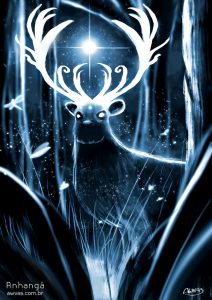
Something both West Africa and South America have in common is the ever looming presence of massive rainforests. These dark and intimidating spaces, full of powerful creatures and mysteries, led to both cultures having a deep respect for nature’s abilities. As a result, many times there would be creatures within both mythologies which would make it their life goal to screw with humans who may threaten the local wildlife or the jungle’s borders.

One of these is the Anhangá, the spirits of the dead who have entered the forest and have taken form within it. Traveling the woods, these spirits could be seen as a brilliant white stag with red eyes, clearly seen for some distance through the thick jungle. Originally just seen in the same way as ghosts in other cultures, over time the Anhangá became responsible for the creatures which live in the woods, acting as a guardian spirit for all other creatures and doing what it could to deceive or misdirect hunters.
The locals believed that when prey had managed to escape, it was likely the work of an Anhangá. Generally, this creature meant no harm to the hunter itself, but it was known that a dishonorable hunter could soon find itself at the mercy of the Anhangá’s powers. One story, speaking of a hunter who used the suffering of a fawn to draw its mother in, ended with the Anhangá using its powers to trick the hunter into murdering his own mother. As a result of this, the Jesuit priests converting the locals towards Christianity began to associate the Anhangá with the devil, the corruption of the name becoming an entity of its own known as the Anhanguera. But, despite their efforts, the locals never truly associated Anhangá with evil, instead showing it cautious respect.

However, the influences made by the Portuguese weren’t always Christian, as demonstrated by their influence on the…
Caipora & Curupira
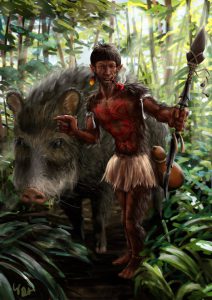
Another example of similar creatures would be the Caipora or Curupira, a pair of small mischievous creatures with strikingly similar features. Often mixed up in stories, the differences between the two is that of some of their features and their intentions. The Caipora, being the more wild and native of the two, is generally depicted as a dark skinned native of the region with a long black mane and animal features – particularly those of a fox. He’s seen as the king of the animals who enforces rules of “Fair Play”, like the Anhangá, where hunters who have acted honorably are rewarded and those who have not are punished. But often, in stories where hunters are being tormented, the methods and style reflect more the creature known as the Curupira instead.

The Curupira, more sprite-like and reflecting a more European aesthetic, has a bright red mane of hair instead and walks with backwards feet. Using these feet, the Curupira will lead the dishonorable hunters astray, causing them to become lost in the woods by leaving trails which move backwards and seem to be leading to nowhere in particular. This antagonism isn’t reserved for hunters, however, as the same can often be done to lumberjacks as well. Often, judged to be a danger to the woods, the Curupira will lead its victims hopelessly into the jungle, never to be seen again. Other powers it demonstrates is the ability to drive people insane with a whistle or trick them using illusions into doing things they’d rather not.
Interestingly enough, the Curupira introduces another element to the melting pot that is Brazilian folklore. As the Portuguese were from the Iberian Peninsula, for a period of time they were part of the Umayyad Caliphate, a Muslim nation which controlled their part of Europe from the 8th to 13th centuries. As such, part of Portugal’s contribution to this mythology is that the Curupira, while specifically existing in the Amazon, is claimed by people in Brazil to be a Genie – a creature with its origins in Islam.
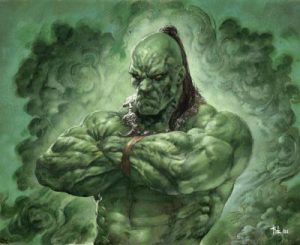
However, in terms of people becoming lost or being led astray, it’s not just the woods someone would need to be careful of, because the river can be full of…
Encantado/Boto

To the people of Brazil, the Amazon River Dolphin held much the same position as Mermaids and Sirens did for those in Europe. Believed to be able to become beautiful people, it was thought that these creatures would be able to seduce someone towards the waters, using their beauty and lovely singing to lure someone nearby and kidnap them – especially women.
As a cruel twist, the origins of the Encantado are much like those of the Anhangá – the spirits of the deceased who have moved on to another form. But, unlike the Anhangá, the Encantado were people driven by greed and lust for power in their lives, eventually ascending to another plane where they exist within a utopia of wealth and comfort. At first, this looks like their wishes coming true, but as time goes on they realize that the most important things in life are missing. Left in a world where everything is handed to them except for what they really need, the Encantado begin to wander the world in Dolphin form, searching for something more fulfilling than that world.

At night, when it’s possible to hide their true nature, the Encantado will sometimes take on their beautiful human form and go seeking human contact. Using a hat to hide their blowhole (a feature they’re incapable of removing from their forms), the Encantado will seek out women, children, and people of interest to take with them back to the lifeless paradise they come from. The thing they need most of all, the company of others, soon leads them to bringing people with them as company – often turning them into Encantado themselves.
However, even those who manage to avoid being kidnapped by these creatures will often be tormented by the encounter. The Encantado can bring down storms, disease, injury and curses on people it encounters – even sometimes bending them to its will through magical means. Women who are left on shore will often be impregnated with the offspring of these creatures before the Encantado eventually returns to take the child back. Others, seeing the Encantado in their dolphin form, will have the misfortune of making eye contact with the creature, driven to madness by the onset of terrible nightmares.
But, while the image of cute little dolphins being terrifying creatures makes all of Brazilian mythology sound a little dark, not everything is out to get you. Some are just looking to have a little fun…
Saci Pererê

A trickster spirit reflecting those of African mythology, and with fairy-like traits, Saci Pererê is best described as “harmless but annoying”. And, while many of the creatures of Brazilian mythology could have existed long before the colonial era, the same couldn’t quite be said for Saci. Other versions existed before, with the “Monopod” in Europe and the “Ŷaci-ŷaterê” of the Tupi-Guarani culture, but neither had all of the traits which could fully describe Saci. While having only one leg (like both stories), a red cap (mirroring the red hair of the Tupi lore), and often depicted with pointy ears (common with European fairies), the feature that marks his relatively new status is the fact that Saci is often described as a young mulatto boy – the child of an interracial couple.
Saci, unlike other creatures on this list, is a harmless creature who will do things that are generally considered “inconvenient”. Lose something? Saci probably took it. Glass break while you weren’t looking? Saci probably knocked it over. It’s said that while Saci would not cause anyone great harm, there is no small harm he could ever pass up. He particularly enjoys tormenting farmers, teasing their animals, misplacing their tools, or straight up ruining those tools so they need to be repaired. Essentially, any small thing that could bother you over the course of the day can probably be blamed on Saci.
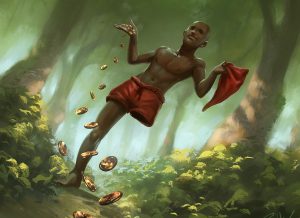
Getting away from the mischief of a Saci is particularly hard, as the little guy is difficult to shake. He can travel invisibly, seen only by the red of his cap and the glow of his pipe. Alternatively, he can become a bird, elusive and noticed only as it spooks you with its song out of nowhere. And, should he be taken with the need to dance, he’ll travel around within a dust devil created by the spinning motions he makes while dancing on his one foot. All together, he can get just about anywhere and at great speed, leaving the target of his mischief unable to escape most of the time. The only means of actually getting away from the bad luck brought on by a Saci being to cross a river or leave a rope of knots in his path. However, there is an alternative to running.
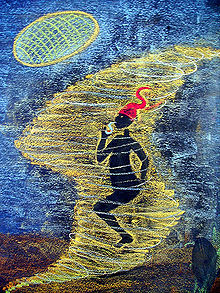
Should you manage to catch the Saci off guard, it’s possible to capture or steal the hat of a Saci. Should someone be able to take the red cap from a Saci, the little mischief maker will grant a wish to a person to get that hat back. And, if you’re really good, you can even capture Saci in a bottle, like a genie, and make it grant you wishes. To do this, however, you need to have a rosary handy and ready to be thrown into a dust devil (as all dust devils have a Saci within). This will snare the trickster who can then be coaxed into a dark glass bottle. Either way, the way you treat a Saci is important because eventually he will have his freedom back and a free Saci can either become an incredible friend or a massive pain in your ass.

In fact, for anyone who watched the Rio games this summer, and saw the things that happened there, one would have to wonder if maybe someone had done something wrong to a Saci. Because, while none of it was particularly dangerous…
Clearly, some mistakes were made.
(I write novels. From time to time, Saci makes that process frustrating. When he does, you’ll find me curse his name on twitter.)







